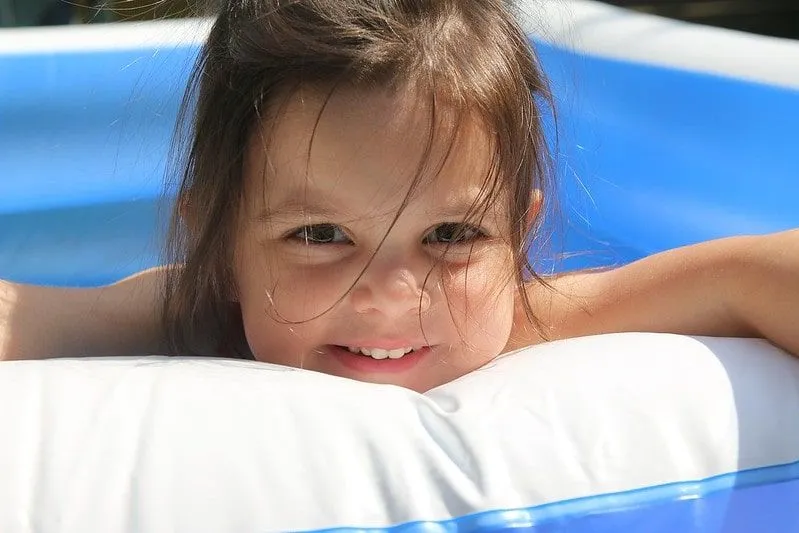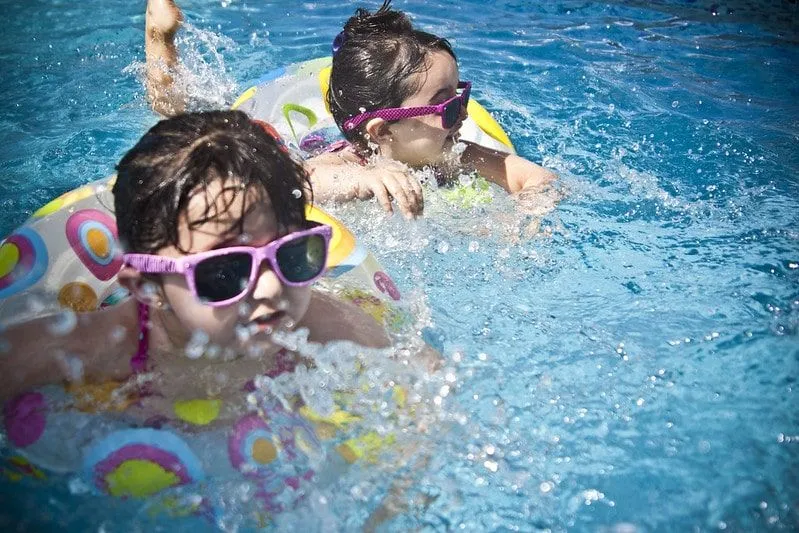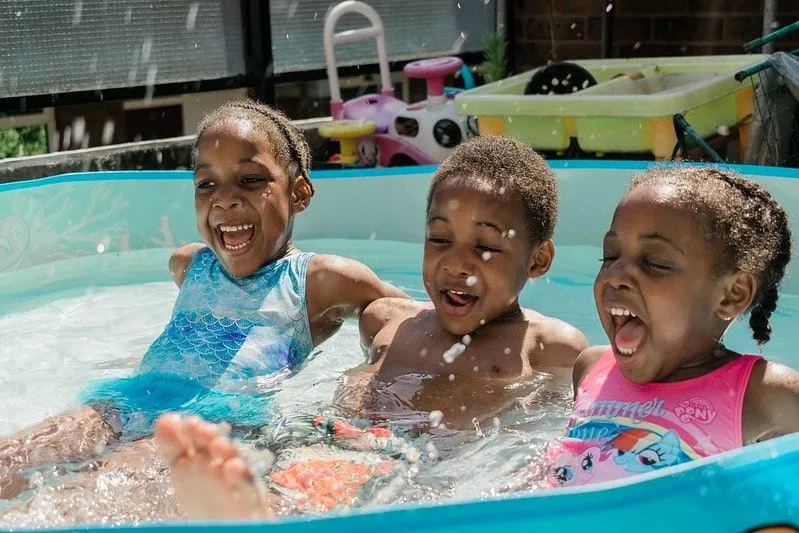FOR ALL AGES
Along with 'what's the weather like today?' and 'where can I buy the best ice cream?' this has to be one of the most Googled questions over the summer.
But just how do you keep your paddling pool fresh and clean without resorting to changing the water daily? We'll let you into a few secrets with some top tips for maintaining the water quality.
First, you should understand more about the water in your paddling pool in your quest for fresh dipping. Over time it will absorb carbon dioxide and this, combined with any 'accidents' children may have, will turn your water acidic. The more acidic the water, the higher its pH level, and the higher the pH level the more likely it is that algae will appear. In short, paddling pools make for ideal conditions for algae to grow, as well as bacteria which can be harmful. Also, be mindful that anyone who later comes down with diarrhoea or vomiting could have easily transmitted their germs to others who were sharing the pool.
But this doesn't have to put the brakes on your summer fun. Ideally, your pool water should be changed at least once a day but there are a few things that can safely extend its lifespan. Set your paddling pool up, let the kids dip in and out and combine with some garden games for a full day's entertainment. No space at home for a pool? Visit one of these parks with paddling pools instead.

This method will certainly not win you any eco-warrior awards but it is a sure-fire way to keep paddling pool bugs at bay. Simply, drain your paddling pool every night after use, give it a good clean with an antibacterial product to keep germs from forming, then leave to dry overnight. Turn it upside down to dry if you want to avoid fallen leaves. You can also try the home-made cleaning solution detailed below. Then you can refill it the next day. If you only have a small pool this method could work and you can reuse the dirty water on your garden rather than letting it go to waste. It's particularly important to ensure larger fabric pools are dry before putting them away for winter.
Every time you do empty your paddling pool make sure to give it a really good clean, rather than just refilling. You don't have to resort to chemical-laden sprays either you can make your own which is just as good at killing off harmful bacteria.
Step One: Once your pool is drained wipe it down with an old rag to get rid of any remaining stagnant water.
Step Two: Mix together equal amounts of water and white vinegar in a spray bottle. Spritz over the pool and use a sponge to clean your pool. If any areas feel slimy use a scrubbing brush on them, the slippery areas may be caused by the presence of algae.
Step Three: Use a hose on a high setting to rinse the pool thoroughly.

Adding chlorine to your pool will keep it clean, but, unless you also have a filter, all of the gunk, algae and general debris will all still be there in the water. But, if you're happy to use chlorine then this is a good way to maintain freshness for a few extra days. The easiest method is to use chlorine tablets along with a floating basket – but this should be removed whenever someone is in the swimming pool. Always carefully read the manufacturer's instructions and only use in quantities that are suitable for the size of the pool. You can also use pH testing strips to ensure you're reaching the right balance – which should be between 7.2-7.8. This method is best suited to a swimming pool or larger paddling pools.
We love this tip from Dri Pak which uses basic ingredients you can find in the supermarket and should maintain the contents of your pool for up to 2 weeks! It's also a safe option for little ones – though of course they shouldn't be swallowing the pool water and should shower after playing in it. The brand of steriliser is specified because of its strength, so stick to this brand to ensure you are cleaning safely. The bicarbonate of soda is added a week later to bring the pH level of the pool to one that won't break down the sterilising fluid. Don't be tempted to switch the bicarbonate for baking soda as it won't give the same effect. When it is time to change the water it will be perfectly safe to use it to water your garden too.
You Need:
Sainsbury's Little Ones Steriliser Fluid
Bicarbonate of soda
Step One: First work out your paddling pool capacity, this should be listed on the box. You'll need this number to work out the number of ingredients to use – never guesstimate this, using the wrong proportions can be harmful.
Step Two: Add 2.5 millilitres of the steriliser fluid for every 100 litres of water you add to the pool.
Step Three: A week later, add 50 grams of bicarbonate of soda for every 100 litres of water you originally placed in the pool. Mix well. Then add the same amount of steriliser fluid as you used in step one again.
If you just want your paddling pool water to last for a few days then your main concern is likely to be stray leaves and bugs falling into it. There's a simple trick to keep your paddling pool water free from unwanted guests using a fitted sheet. The size of your paddling pool will determine the size of the sheet you need, but once kids have finished using the pool simply stretch the sheet over the top. While it won't freshen the water it will stop every leaf, bug and blade of grass from making use of the pool while the kids sleep.

Use a net to fish out debris that lands in the pool straight away.
Place a towel beside paddling pools and encourage swimmers to get in by walking on the towel first. This should limit the amount of grass going in pools.
Make sure to do a thorough pool clean at the start and end of every season.
Read The Disclaimer
At Kidadl we pride ourselves on offering families original ideas to make the most of time spent together at home or out and about, wherever you are in the world. We strive to recommend the very best things that are suggested by our community and are things we would do ourselves - our aim is to be the trusted friend to parents.
We try our very best, but cannot guarantee perfection. We will always aim to give you accurate information at the date of publication - however, information does change, so it’s important you do your own research, double-check and make the decision that is right for your family.
Kidadl provides inspiration to entertain and educate your children. We recognise that not all activities and ideas are appropriate and suitable for all children and families or in all circumstances. Our recommended activities are based on age but these are a guide. We recommend that these ideas are used as inspiration, that ideas are undertaken with appropriate adult supervision, and that each adult uses their own discretion and knowledge of their children to consider the safety and suitability.
Kidadl cannot accept liability for the execution of these ideas, and parental supervision is advised at all times, as safety is paramount. Anyone using the information provided by Kidadl does so at their own risk and we can not accept liability if things go wrong.
Kidadl is independent and to make our service free to you the reader we are supported by advertising.
We hope you love our recommendations for products and services! What we suggest is selected independently by the Kidadl team. If you purchase using the buy now button we may earn a small commission. This does not influence our choices. Please note: prices are correct and items are available at the time the article was published.
Kidadl has a number of affiliate partners that we work with including Amazon. Please note that Kidadl is a participant in the Amazon Services LLC Associates Program, an affiliate advertising program designed to provide a means for sites to earn advertising fees by advertising and linking to amazon.
We also link to other websites, but are not responsible for their content.
Was this article helpful?



We’ll send you tons of inspiration to help you find a hidden gem in your local area or plan a big day out.



Check your inbox for your latest news from us. You have subscribed to:
Remember that you can always manage your preferences or unsubscribe through the link at the foot of each newsletter.